It is not that words are imperfect, or that, when confronted by the visible, they prove insuperably inadequate. Neither can be reduced to the other’s terms: it is in vain that we say what we see; what we see never resides in what we say.Michel Foucault, The Order of Things: An Archaeology of the Human Sciences (1970)1
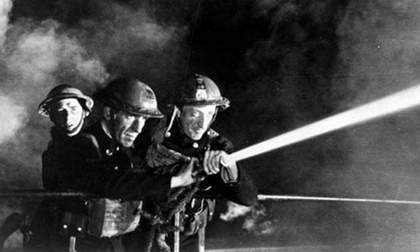
Fig.1
Humphrey Jennings
Fires Were Started 1943 (film still)
On the night of the premiere of The Girl Chewing Gum, the 7.00 pm slot at the London Film-Makers’ Co-operative (‘the Co-op’) featured a very different film, one that lay far beyond the domain of structural/materialism: Humphrey Jennings’s Fires Were Started of 1943 (fig.1). Set in the period preceding the formation of the National Fire Service in Britain in August 1941, the film follows a day’s work at a fire service substation during the Blitz, culminating in a massive warehouse fire. Even though it consists entirely of scripted re-enactments, the film was at the time of its release referred to as a documentary due to its use of real firemen and firewomen as actors and its research-based claim to historical actuality.2 At the Co-op, it was shown as a part of an ongoing series entitled ‘History of the Avant-Garde’, which included many experimental film classics, but notably also feature films such as Robert Flaherty’s 1948 Louisiana Story and Dziga Vertov’s Three Songs of Lenin (Tri pesni o Lenine) of 1934. Like Fires Were Started, these films complicate the premise held by the proponents of direct cinema that documentary might be best defined as the observational recording of unstaged events and best understood in opposition to fiction and manipulation. Although the very notion of documentary was anathema to structural/materialism, the screening of films such as these is evidence of a more complex interrogation of the documentary tradition occurring at the Co-op during this period than is commonly assumed.3 Rather than taking the indexical capture of reality as something to be ‘for’ or ‘against’, the conception of documentary resuscitated in the ‘History of the Avant-Garde’ series was marked by a constitutive impurity and an insistence on exploring the fraught, transformational space that exists between reality and its representation.
It was only through the arbitrariness of scheduling that The Girl Chewing Gum came to share the evening with Fires Were Started, but in fact this somewhat strange pairing makes a good deal of sense: albeit for very different reasons and to very different ends, both films are characterised by a productive contamination of fiction and non-fiction. Smith has discussed this aspect of his work, stating that ‘If I’m forced to put a label on my films, I’m happy to call many of them documentaries, especially if you go back to [John] Grierson’s definition of documentary as the “creative treatment of actuality”’.4 He elaborated on this position in his 1997 doctoral dissertation, entitled ‘Real Fiction’: ‘I am highly sceptical of the accepted distinction between “fiction” and “documentary”. Leaving aside philosophical arguments concerning the concept of “fact”, all film is fiction in that it is literally “made up” from controlled representations of selected interpretations of phenomena which are ordered selectively to construct meanings.’5
This twinned interest in documentary and the non-transparency of representation prevails throughout Smith’s practice, but is articulated with particular force in The Girl Chewing Gum in its exploration of the relations between language and image. Smith’s expanded definition of documentary and acknowledgement of the inevitability of fictionalisation are now widely held ideas – indeed, they are frequently deemed central to the so-called ‘new’ forms of documentary that prevail today in contemporary art – but this position was far less common in the 1970s. In The Girl Chewing Gum, Smith’s embrace of hybridity provides a cogent form for a powerful critique of documentary naturalism and, more specifically, one of its favoured techniques, the ‘voice of god’ – all while remaining grounded in a commitment to actuality.
The voice of god is a usually male voice, unmarked in accent, prevailing on the soundtrack of many traditional documentaries. It assumes total knowledge and mastery of what is seen onscreen by virtue of occupying a space resolutely heterogeneous to that of the image-track. The power of this voice is dependent on the absence of a body; it seems to speak from nowhere, deriving from this placelessness a superhuman omniscience. The Girl Chewing Gum does not present a voice of god in the strict sense, since conventionally, to quote the filmmaker and critic Pascal Bonitzer, this voice ‘forbids questioning about its enunciator, its place, and its time’.6 The opening minutes of The Girl Chewing Gum depart from this regime by allowing the spectator to assume that the voice is located in a space coterminous with the image, simply out of frame; in other words, the voice is initially presented as a voice-off rather than a voiceover. The distinction between these two terms is key in illuminating the way in which The Girl Chewing Gum subverts filmic conventions. The voice-off in cinema is defined as belonging to a character not visible in the frame and yet clearly present within the filmic universe. The voiceover, meanwhile, is extra-diegetic, occupying a space that is radically other; it derives authority from this transcendental position.7 The Girl Chewing Gum cannily subverts the habitual employment of these techniques by beginning with a voice-off that possesses all the authority of a voiceover, only to later reveal it as a voiceover lacking any authority whatsoever. Through this unusual deployment of the relationship between the disembodied voice and filmic space, Smith produces a critical reflection on the ways in which the soundtrack’s linguistic message regulates the viewer’s apprehension of the image.
Bonitzer wrote that the voice of god is ‘able to seize the real’, transforming it into the ‘visual and perceivable support of the commentary – if one likes, its flesh’.8 The Girl Chewing Gum stages this seizure of the real within a (bogus) scenario of the production of a fiction film – a situation in which a director would, as in Day for Night, be able to control all aspects of the filmic world. What the voice says, the real does. All of the contingencies of the world are subordinated to the pure intellect of the commanding voice, even the flight of pigeons. But as this conceit quickly and amusingly unravels, it becomes clear that the film’s real interest lies in the seizure of the image of the real through language, by means of a process the literary and cultural theorist Roland Barthes term has termed ‘anchorage’. In his 1964 essay ‘The Rhetoric of the Image’, Barthes described how images are marked by an inherent polysemy – that is, they are open to many possible meanings. Linguistic forms such as voiceover serve to fix certain meanings while discarding others, all in an effort ‘to counter the terror of uncertain signs’.9 By naming and supplying information about particular elements of the scene, the voiceover of The Girl Chewing Gum helps one to, in Barthes’s words, ‘choose the correct level of perception’, ‘to focus not simply [one’s] gaze but also [one’s] understanding’.10 In standard voice-of-god commentary, the voice dissimulates its seizure of the real by adopting a form of discourse that masquerades as fact-based and neutral. It purports to say what is simply ‘there’, to transparently elucidate the real through the provision of a verbal supplement, when in fact what is occurring is an operation of selection and transformation whereby reality is fictionalised. The Girl Chewing Gum stages an allegory of this operation, revealing the voice of god’s true function and its false pretence to authority.
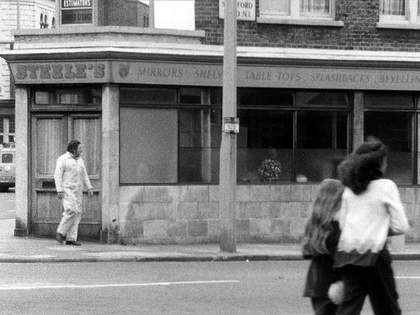
Fig.2
John Smith
The Girl Chewing Gum 1976 (film still)
Courtesy the artist and Tanya Leighton Gallery, Berlin
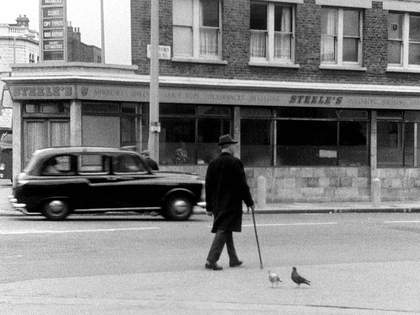
Fig.3
John Smith
The Girl Chewing Gum 1976 (film still)
Courtesy the artist and Tanya Leighton Gallery, Berlin
Smith’s voice directs not only the scene, but the viewer as well, guiding him or her to focus on certain aspects of the image and to apprehend those aspects in particular ways. When the voiceover says ‘Right, let’s have the man in the white boiler suit coming in from the right’, the viewer scans the image in search of him at the expense of paying attention to other things happening in the frame. His appearance on the far side of the street in the background on the left – not the right as directed – detracts notice from two women who pass in the foreground, even though they occupy a position of greater pictorial importance (fig.2). In addition to directing the spectator’s gaze, the voiceover plays a central role in determining what sense one makes of what one sees. Put differently, it influences not only identification, but interpretation as well. We see a man with a cane walking down the road (fig.3). He could be going to any number of places for any number of reasons; the image contains within it a vast reserve of potential meanings. When the voiceover volunteers that ‘The man with a walking stick is going home’, it accomplishes a pruning away of undesired possibilities (the man is a wounded war veteran, the man uses his cane to beat his dog) and anchors one chosen signified to the image. Although this example is quite innocuous, it is easy to see how instrumental the operation of anchorage can be in the ideological functioning of images. As Barthes wrote, ‘With respect to the liberty of the signifieds of the image, the text has thus a repressive value and we can see that it is at this level that the morality and ideology of a society are above all invested’.11
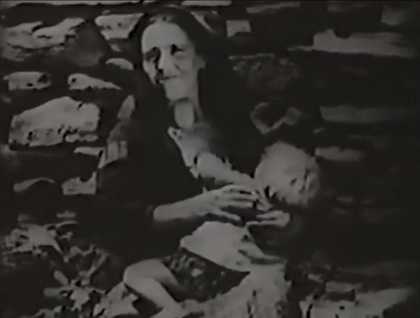
Fig.4
Luis Buñuel
Land Without Bread 1933 (film still)
The danger of the voice of god is that it powerfully exerts this repressive value without acknowledging it as such; instead, the chosen signified anchored by the voiceover is presented as obvious, as the unquestioned truth of the image. The Girl Chewing Gum critiques this regime not by offering an alternative, but by endowing the voice with such extreme power so as to strain one’s belief in it as master of the universe. As Bonitzer has written, ‘If the unity of voice and meaning in the commentary-off defines a regime of mastery or of oppression, it is perhaps starting from its scission that one could begin to define another politics or erotics of the voice-off’.12 Bonitzer found an example of such tactics in the films of Marguerite Duras, which render the voice hesitant, doubtful, unknowing and marked by silences that endow it with a character very other than the pure rationality of the voice of god. Smith, by contrast, deploys a technique not unlike that found in a second example Bonitzer offers, Luis Buñuel’s Land Without Bread (Las Hurdes: Tierra Sin Pan) of 1933, a film that tackles the tyranny of the voiceover head on. Buñuel’s voiceover adopts a tone incongruous with the image it describes and makes statements that lie beyond the possibilities of its knowledge. It often attempts to anchor a linguistic signified that is at odds with the photographic signifier, declaring, for instance, that a woman onscreen is ‘only thirty-two years old’, even though she looks perhaps seventy (fig.4). Although Smith does not stage contradictions as blatant as Buñuel’s, he systematically undercuts the reliability of his narrator through similar means, particularly in the second half of the film, in which he flatly reports on incredible sights (the blackbird with the nine-foot wingspan) and makes frequent reference to information indiscernible by vision alone. The revelation of the specific location of the narrator far from Dalston further demolishes the voice’s authority, constituting what might be thought of as the avant-garde equivalent of the pulling back of the curtain at the end of The Wizard of Oz (dir. Victor Fleming, 1939). These gestures induce the kind of scission Bonitzer described, with the result that the voice of god is recast as the voice of an individual with a god-complex. If this voice is clearly engaged in fabulation beyond the limits of its knowledge, it follows that there are no grounds for trusting its statements. A chasm opens between what is said and what is seen. The filmic image slips away from the linguistic message that sought to capture it, recovering its polysemy and casting doubt upon the enunciative position of all voices that pretend to authority and omniscience.
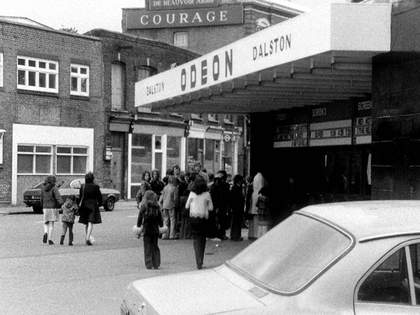
Fig.5
John Smith
The Girl Chewing Gum 1976 (film still)
Courtesy the artist and Tanya Leighton Gallery, Berlin
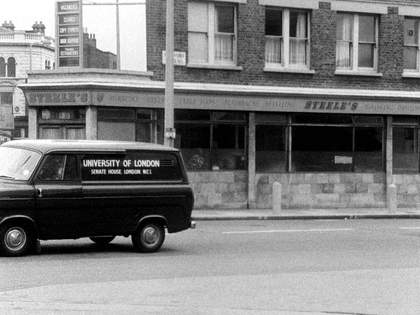
Fig.6
John Smith
The Girl Chewing Gum 1976 (film still)
Courtesy the artist and Tanya Leighton Gallery, Berlin
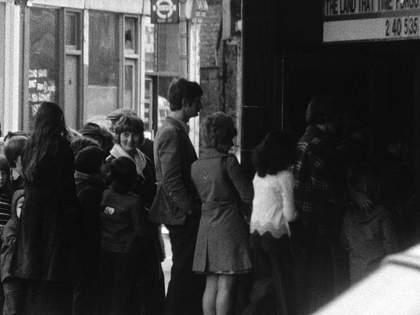
Fig.7
John Smith
The Girl Chewing Gum 1976 (film still)
Courtesy the artist and Tanya Leighton Gallery, Berlin
There are key moments in which Smith plays with the synchronisation of sound and image so as to throw a wrench in the usual functioning of anchorage. Roughly halfway through the film, the camera comes to rest on the exterior of the Dalston Odeon, with a queue waiting in front (fig.5). The voiceover mentions a man in a turban and a van marked ‘Senate House, WC1’, but neither can be found. He continues, ‘In the cinema queue I want to see a boy and his mother. The boy will be about eight years old and his mother about thirty-two. They’ll both have collar-length hair, his dark and hers fair. She will be wearing a suedette coat with a white imitation fur collar. They’ll be talking to each other and looking around them’. Scanning the crowd, it is not possible to identify anyone who fits the description Smith has provided. At the mention of the woman’s coat, the camera begins to pan left away from the cinema, so that the queue is completely out of frame. The viewer is being directed to look for something that he or she simply would never be able to see. The voiceover has offered a selected signified, but no signifier to match can be found, troubling the production of a stable meaning. After a perfect sound-image synchronisation of a man putting on his glasses, the voiceover speaks once again of mother and child – ‘The boy will look at his watch and yawn, then look at it again and say something to his mother about the time’ – but the cinema queue remains out of frame. What is visible, however, are the man in the turban and the Senate House van, mentioned roughly one minute before (fig.6). Almost four minutes later, after the geographical location of the voice has been revealed and its narration is about to end, the camera comes once more to the cinema queue, where the mother and boy are clearly visible, clothed exactly as the voiceover had said they were (fig.7). But by now, the notion that the text might serve to successfully anchor the meaning of the image by identifying figures of interest and supplying interpretive details has been thrown into crisis. How are we to know that the woman is indeed thirty-two, not coincidentally the same age as the woman of Buñuel’s Land Without Bread? She might easily be twenty-eight, or she could be forty; she is one face among a crowd and too far away to know. And perhaps her fur collar is real rather than imitation? By the end of The Girl Chewing Gum, the narrator’s authority has been so thoroughly undermined as to restore the liberty of the photographic signifieds.
This sequence is of central importance for an additional reason, one that has to do with the same thing the boy in the cinema queue spoke to his mother about: time. From the beginning The Girl Chewing Gum establishes a tight synchronisation between the commands issued on the soundtrack and their execution by the image, one that it largely retains throughout. The synchronised sound of the street scene aids in the creation of a reality-effect, and the soundtrack is presumed to be a single unitary whole. But in the case of the mother and son, this synchronisation is disrupted as the voice supplies information prematurely, identifying figures that will only appear onscreen later. This disjunction between sound and image tugs at the tight suture that had existed between them, opening the possibility that the voice may be speaking from a different temporal position than originally assumed. Even before the disclosure of the geographical location of the narrator, this lack of synchronisation gestures to the film’s process of construction by suggesting that the voiceover is – if not clairvoyant – occupying a time after the image. This destabilising of the temporality of the soundtrack is exacerbated shortly thereafter when another mother, ‘firmly gripping the hands of her two young sons’, stops to cross the road. The narrator says ‘They stop– ’, at which point the street noises cut out and the soundtrack is quiet. He continues against a silent background, ‘–and now they cross the road’. As they begin to walk, the street noises return. Smith has here made clear the presence of two soundtracks that had been masquerading as one, cleaving their unity and putting into question the place and time from which the narrator speaks.
The heterogeneity of film’s soundtrack and the foregrounding of the belatedness of the voice have two important ramifications for Smith’s critique of documentary naturalism. Firstly, it means that the voice speaks not as witness to the street scene but as viewer of the film of the street scene, which can be screened repeatedly so as to familiarise oneself with the sequence of events. This attenuates the relation to the profilmic and foregrounds the image-track as representation rather than reality. Secondly, it fractures the temporality of the film, for what had been apprehended as a single unfolding present is now recognised to be a heterogeneous time in which non-simultaneous recordings of sound and image are rendered simultaneous only through the means of filmic construction. Their apparent unity is shown to be the result of post facto assembly. The artifice of post-synchronised sound is, of course, the truth of most films, but this fact is normally disavowed so as to produce an impression of reality. As the composer and film theorist Michel Chion has suggested, ‘The talking film is but a jerry-rigged assemblage … Instead of denying this rigging, it can choose it as its subject matter, taking that route, under the sign of the impossible, to the very heart of the effect of the Real’.13 The Girl Chewing Gum inhabits this impossibility to reveal it as such, thus adding a critique of the reality-effect of synchronised sound to its analysis of the signifying operations of the voice of god.
